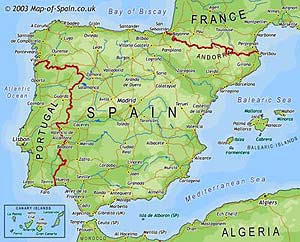

The origin of tapas is the subject of many an argument in the local bar. It is said that the first tapa was simply a hunk of bread which was placed over the glass to keep the flies out. Hence the word ‘tapas’ was born. Tapa literally meaning ‘cover’ or ‘lid’.
In the beginning somewhere must have been the olive - plain and simple, on its own. What better accompaniment to a glass of dry fino sherry?
Or perhaps some almonds; fried in olive oil, sprinkled with salt and served while they’re still hot? These are the original tapas; the simplest of foods, requiring little or no preparation.
As the tradition developed, tapas became more of an elaborate event, with each region developing their own specialities. They were still 'little dishes' but the personalities of thousands of bar owners all over Spain has stamped them with the identities that they have today.
 Spain's landscape is extremely diverse and covers areas such as mountain ranges and dusty plains, olive and fruit groves plus fertile orchards and rich arable lands.
Spain's landscape is extremely diverse and covers areas such as mountain ranges and dusty plains, olive and fruit groves plus fertile orchards and rich arable lands.
Spain also has climate extremes. Regions that are cold and wet, regions that are hot and dry, and just about everything in between. It has a huge coastline, facing both the Atlantic ocean and the Mediterranean sea.
Spain's fishing industry is one of the most active, and pro-active, in Europe. Hardly surprising then, that the cuisine of its coastal regions is very heavily based on fish and seafood.
Age-old regional methods and local ingredients have been influenced throughout the country's long history by the incorporation of many ingredients and influences from different cultures and countries.
The east coast was invaded by the Romans, who introduced the olive and irrigation methods.
The invasion of the Moors also brought olives to the south, as well as almonds, citrus fruits and fragrant spices. The influences of their 700 year occupation remain today, especially in Andalucia.
The discovery of the New World brought with it the introduction of tomatoes, sweet peppers (capiscums), chilli peppers, beans and potatoes. These were readily accepted and easily grown in Spain's ideal micro-climates.
Spanish food, and especially tapas, is based on simple methods and the imaginative use of seasonal vegetables and local ingredients. Tapas is essentially hearty and unpretentious. Ingredients are fresh, flavours are robust and recipes are easy. Preparation and presentation is generally pretty straightforward.
You'll find no 'pan-fried' this and 'sun-blushed' that here, my friend. The success of a dish is purely down to one basic rule: whether or not it tastes good.
Which, I hope you agree, is how it should be.